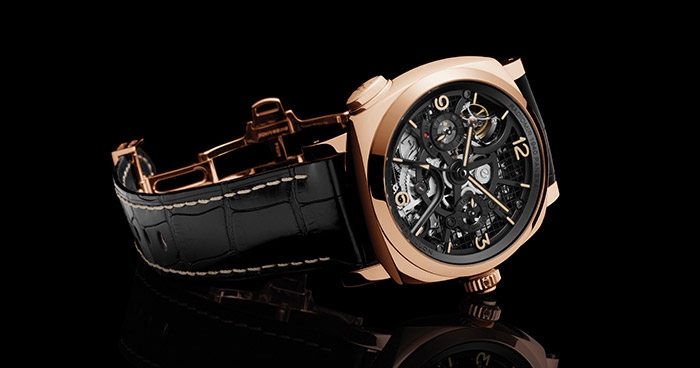Officine Panerai unveils Radiomir 1940 Minute Repeater Carillon

The 49mm Radiomir 1940 Minute Repeater Carillon Tourbillon GMT – with its exclusive Tourbillon Regulator and the remarkable double minute repeater mechanism chiming either local time or a second time zone – is technically the most complicated watch ever made by the Panerai manufacture in Neuchâtel.
Bells have played a significant role in history, with their pealing or tolling announcing births, deaths, victories, crises, and so on, in addition to their main function of marking the passage of time. In haute horlogerie, the chiming of bells as an indicator of time has translated into the delightful complication of the hour and minute repeater mechanism, which causes the watch to chime by simply pressing on a push-piece.
For the creation of the new Radiomir 1940 Minute Repeater Carillon Tourbillon GMT, or the PAM00600, Officine Panerai has sought inspiration from its own history that has been indissolubly linked for over a century to the sea – and from the marine tradition of marking the passage of time by a ship’s bell. This ancient tradition is invoked again today by the special tones of the chimes of their new Special Edition timepiece created by the Panerai Haute Horlogerie Manufacture in Neuchâtel.
The Carillon: Three different melodious sounds for indicating time
For the PAM00600, Officine Panerai has developed the new P.2005/MR Manufacture movement, a handwound skeleton calibre fitted with a high-end minute repeater mechanism with distinctive technical characteristics.
The chiming is activated by a push-piece at 8 o’clock, and is carried out by three hammers that strike an equal number of gongs fixed to the movement and the case. The choice of three hammers, instead of the traditional two, enables three different sounds to be combined, so that the carillon can play a melody, like that of a bell. As is traditional, the first gong is the lowest and identifies the hour, while the last and highest indicates individual minutes. Another unusual feature is that the second gong sounds triple chimes of an intermediate note, each triple chime corresponding to ten minutes instead of the traditional fifteen.

In an ordinary repeater, the time 10.28 is usually indicated by ten chimes for the hour, a different chime for the quarter-hour and thirteen individual chimes for the rest of the minutes. In Panerai’s Minute Repeater Carillon, however, the sequence consists of ten chimes for the hour, then two triple chimes (indicating two ten-minute intervals) and eight single chimes. The system of tens, reducing the number of chimes, makes telling the time easier and quicker, and also corresponds to the customary manner in which time is now indicated by digital watches.
The quality of sound propagated by the minute repeater is also enhanced by the specificities of the red gold used in making the case and by its structure – two parts created separately and then soldered together. The manual touch in the handiwork of master watchmakers gives the sound of each watch a unique character, similar yet imperceptibly different from each other.
The innovative double hour and minute repeater mechanism
The most remarkable feature of the Minute Repeater Carillon is that the repeater function can be activated both for local time and for a second time zone, which is indicated on the dial by the central arrow hand and the am/pm indicator on the counter at 3 o’clock.
To avoid accidental activation, the carillon can be operated by the push-piece at 8 o’clock only when the winding crown is rotated slightly. The degree of rotation required is shown by a black indicator placed on the side of the crown: when the indicator can be seen from the front, the carillon cannot be sounded but, by a single pressure on the push-piece on the crown, the local time or the second time zone can be selected, and the red HT/LT (Home Time/Local Time) indicator at 8 o’clock marks which of the two alternatives is in force.
The Tourbillon Regulator patented by Officine Panerai
As well as the minute repeater mechanism, the handwound P.2005/MR calibre, the result of four years of research and development by the Laboratorio di Idee in the Neuchâtel Manufacture, also has the remarkable Panerai Tourbillon Regulator, which can be admired from both the front and the back of the watch, thanks to skeletonisation.
The rotation of the tourbillon in the system patented by Officine Panerai is different from that of the classic tourbillon. In the traditional version, the balance cage rotates continuously on itself, cancelling out any variations caused by gravity and possible shocks. In the Panerai mechanism, the tourbillon cage rotates on an axis that is perpendicular, and not parallel, to that of the balance.

Also, while the rotation is once a minute in a traditional tourbillon, in the P.2005/MR it takes 30 seconds, and is shown by an indicator that rotates in the small seconds counter at 9 o’clock. The greater speed and the particular arrangement of the mechanism enable it to compensate for any changes of rate very effectively, ensuring a very accurate precision timepiece.
The skeletonising provides better acoustic performance and enables the sophisticated technology of the P.2005/MR calibre to be admired. All the elements of the dial are directly mounted on the movement or on the flange, which has the engravings ‘Radiomir 1940 Panerai’ and ‘Minute Repeater Carillon’. The little hammers of the minute repeaters and the two spring barrels, which store a power reserve of at least four days, are visible from the open back, through which the power reserve indicator mounted on the movement can also be read.
Branding and personalisation
The new PAM00600 has the characteristic Panerai features, such as the historic 49mm Radiomir 1940 case and the Super-LumiNova-covered bar markers and figures. The 18 carat red gold case is corrosion-resistant, has excellent sound-propagating properties, and is water- resistant, guaranteed to 3 bar (equivalent to a depth of about 30 metres).
For this bespoke Special Edition watch, Officine Panerai offers personalisation – in the choice of strap, of the hands or of other special features, including the possibility of a case made of other materials.





